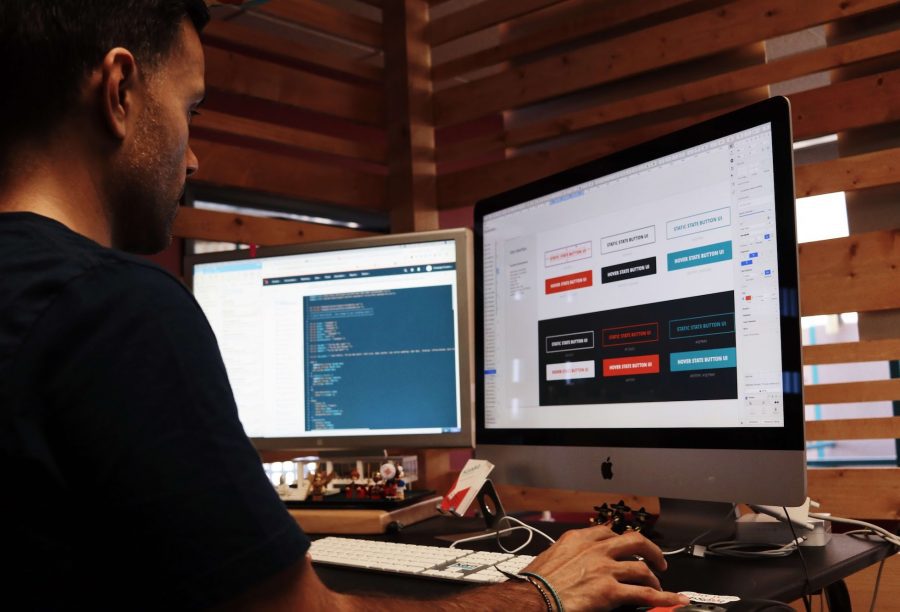
Website design is a combination of technical proficiency and creative innovation, so it’s vital that designers stay ahead of the curve within the industry. Cutting edge ideas, emerging companies, or who’s winning the big awards, they all play a huge part in how you progress as a professional. You have to keep up with the changes in the web design industry.
You are an important cog in the industry machine and developments within it reflect upon you and your work. If you’re looking for the best way to keep up to date with everything happening across the world of web design, here are four interesting methods we find enlightening.
Social Media
Social media isn’t just for sharing gifs and spying on old school friends. It’s also an effective research tool. Whether you’re on Facebook, Twitter, or LinkedIn there are a plethora of great conversations happening between insightful voices to keep you up to date with what is happening in the world of web design.
![]()
The constant stream of social media gives you the chance to latch onto new innovations in web design quickly and watch these ideas get explored and refined in real-time. Influencers use social media as a space to think out loud. You should set up a custom list of people you find interesting within the web design world or follow existing ones from other professionals. This gives you a better chance of not missing anything you may have in your regular feed.
Social media channels can give you a peek into the future, as web designers give hints of what they’re working on and exchange solutions. Keep a close eye on what they’re getting excited about and use it to improve your own work. Engage with these accounts and search using hashtags to give yourself an even better chance of staying up to date.
The breadth of social media means that most people within the tech industry are active on there anyway, so you won’t have to dig deep to find interesting voices. Explore outside of recognizable names and your niche though, so as to enjoy the most varied and informative experience.
Keep Up With Thought Leaders
Whatever industry you’re in, following the words and pontifications of thought leaders is essential for keeping up to date with how the best and brightest.
A thought leader is essentially someone at the forefront of innovation within an industry or someone who understands it and is about to explain the details concisely. Keeping up with thought leaders means following their blog, reading guest post content they write for other blogs, and attending any talks or roundtable discussions they may be having.
This helps you to learn about new innovations from the people directly making them and gain an understanding of the industry in greater detail from people interacting with other leading minds all the time.

Some thought leaders are at the forefront of providing content to other websites too, most notably online encyclopedias.
College professors may say to never use Wikipedia as a source, but alternative online encyclopedias are still an excellent source of knowledge. Everipedia is probably the most interesting alternative to Wikipedia, enforcing a much more lenient set of rules to allow for a wider breadth of content on more niche topics.
This is perfect for thought leaders looking to create permanent records of specifics within web design, and for you to find follow up articles on techniques and technologies mentioned in blogs.
Find the kind of thought leaders who speak in a language that you understand. Trying to learn too much at once will make the process redundant.
Freelance Working
Working freelance or being self-employed is slowly becoming the prevailing trend within much of the tech world. Not only does it free you from the conventions of the nine to five grind, but it opens you up to the possibility to learn from lots of unique sources.
If you’re working freelance and outsourcing your skills to a different company for a week or a month at a time, you aren’t trapped within the same office surrounded by the same thoughts and voices forever.
This gives you the chance to work out new styles and innovations much more frequently than someone in a permanent position, giving you new skills and methods to implement into your repertoire.

It also affords you the opportunity to get your name out there to as many industry professionals as possible. This leads to further conversations about ways of doing things down the line and works in new spaces.
Offices and small businesses are becoming more and more accepting of external freelancers working amongst them. It’s very easy to get caught up in your own little work bubble and believe the way you do things is correct, so moving into new environments where you’re forced to ask questions and acclimatize is great for self-improvement.
YouTube
Many of us learn through visuals. We understand visuals and can draw information from them. Maybe that’s why we became web designers. Sometimes though, it can be difficult to draw information from just still images. That’s why video is such a brilliant and vital learning tool.
I’m sure you don’t need me to tell you how much of a behemoth YouTube is, it’s only the most visited website in the United States. It may be a platform we more commonly associate with entertainment than education, but it has excellent potential to teach you a lot about web design.
There is a huge community of creatives and website designers on YouTube discussing new advancements and showing off new tools, some developing into huge channels such as Quentin Watt Tutorials.

Likewise, if you have a query about something new in the world of web design, there’s no platform more likely to have a more easily accessible in-depth guide than YouTube. Unlike a limited blog post, a YouTube guide will run you through the latest tool or trick in a format you can pause and analyze. This gives you a holistic view of everything to do with the tool in an easy to consume format.
The best web designers won’t scoff at the idea of learning from YouTube. You may be watching a video made by a teenager in a bedroom, but it could teach you something about web design you may not pick up anywhere else.
Website design is a growing industry with a tremendous amount of potential, and the exact same can be said for the world of web design education. If you’re looking to get ahead in this industry you owe it to yourself to use these methods and stay informed.

